Recommendation Letter for Scholarships | Format, Template & Samples
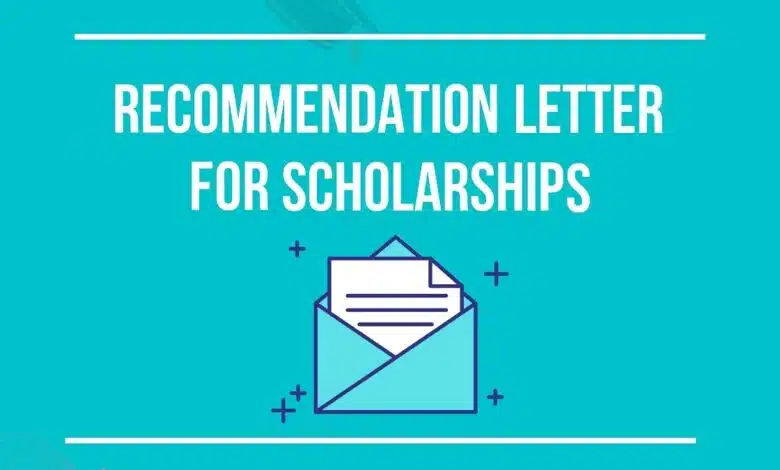
A recommendation letter for scholarships or scholarship reference letter in academic processes and scholarship applications is a word document or pdf in which a third party introduces himself, discusses how he came to know you, and explains why he recommends you for the relevant study or scholarship programme.
Content
- Why do you need a recommendation letter for scholarships when applying?
- How to write a recommendation letter for scholarships
- Pointers for writing a letter of recommendation professionally
- Formatting tips for a recommendation letter for scholarships
- Reference letter template
- Recommendation letter sample for scholarship
- Do’s & don’ts when writing a recommendation letter for students
Crafting a professional recommendation letter for scholarships is crucial to winning great opportunities, as every year, thousands of eligible students submit applications for many of the most well-known scholarships and just a small portion of them have the chance to make their dreams come true.
The recommendation letter for scholarships (scholarship reference letter) should ideally be written by your recommender. However, you could find that the instructors and mentors with whom you connect most are ALSO the ones who have the least free time. As a result, they can ask you to write the first draft by yourself.
Whether you are a student or an instructor, you should know that writing a recommendation letter for scholarships is a great responsibility because it will play a major role in winning the scholarship or not when most of the applicants seem similar in competence and qualifications to a large extent. In other words, your student’s success (or your success) depends in part on your recommendation letter, so write it professionally!
So, if you are willing to write a scholarship reference letter, must read this article carefully.
Let’s begin straight away!
Why do you need a recommendation letter for scholarships when applying?
Many scholarship applications undergo a lengthy reviewing process that takes months. And throughout that period, there may be a lot of criticism of students who, on paper, frequently begin to resemble one another. Therefore, writing a strong recommendation letter for a student means enhancing the selection committee’s comprehension of his prospects for success and individual academic skills.
However, your scholarship reference letter can only accomplish those goals if it contains all the details scholarship selection committees are seeking. Giving an unbiased perspective on how the student shows qualities the scholarship foundation really wants to be represented in its scholars.
Your scholarship reference letter is used by the committees that choose the scholarship recipients to gain an outside viewpoint on the applicant. This makes it a little bit simpler for them to choose the students who deserve it the most.
Although writing a recommendation letter for scholarships seems to be hard, it can be so easy when you know what to focus on. Fortunately, there is a quick and simple approach for you and your students to gather all the data required to compose an effective recommendation letter for scholarships. Later on in this article, we’ll explain what it is.
How to write a recommendation letter for scholarships
Every student that asks for a professional letter of recommendation for scholarships or university admission from you, has probably been different from others. therefore, you should make sure that each reference letter sounds genuine and not like it was copied from a reference letter template.
However, all the scholarships recommendation letter structures are similar, and this is a template of reference letter that work best:
- A brief introduction outlining your identity, your relationship with the candidate, and your level of familiarity with him.
- Describe the student’s intellectual qualifications, character traits, and college preparation in generic terms.
- Details to back up those findings and ideas.
- A succinct summary outlining your reasons for selecting this student for the award.
- A closing indicating your readiness to be contacted for more details if necessary.
Although knowing the basic letter of recommendation template is of great importance, there are some pointers you must know to make a good reference letter.
Pointers for writing a letter of recommendation professionally
Step 1: Find the right person
Therefore, if you’ve established a strong relationship with your supervisor, mentor, or professor, it’s time to request a scholarship reference letter. It’s preferable to get a recommendation from a professor or someone who is familiar with you and enthusiastic about supporting your ambitions to pursue further education.
Be careful: if you graduated more than two years ago and haven’t maintained contact with your instructors, you must be very careful about who you select to serve as a reference and how you approach him to ask for one.
It is preferable to choose academics with whom you had the best contact or stood out so they will remember you when you get in touch with them. we recommend you initiate contact to reestablish the connection before you ask for writing a letter of recommendation. To do this, send to the professor an email, make a phone call, or even pay him a visit in person to give him an update on your activities throughout the intervening period, inform him about your plans to continue your education, and solicit his opinion.
Ideally, your individual of choice will have the time to create a personalized letter for you that highlights your skills, interests, intelligence, compassion, and more. However, there are situations when your selected recommender could urge you to compose the “letter of recommendation draft” yourself. This can assist guarantee that your scholarship reference letter has all the information you want to emphasize about yourself while also saving your recommender time.
Step 2: Brainstorm letter of recommendation ideas
It could be a little intimidating to consider writing your own letter of reference. However, it offers you the chance to make sure that the recommendation letter for scholarships highlights everything you want a scholarship or admissions reviewer to know about you.
Making an outline for your letter of recommendation template is an excellent place to start. Make a list of the bullet points you will address in each of the three sections—the introduction, body, and conclusion. Don’t include anything that your recommender/professor would not fairly know about you through your relationship.
Step 3: Preparing to write your first draft of a recommendation letter
Being uncomfortable with “tooting your own horn” is one of the most difficult aspects of drafting your own reference letter:
- Show your parents or other trusted people your outline to get their assistance.
- Ask for feedback since you could have “undersold” yourself.
- Express just enough to persuade the readers that you are a worthy candidate in a letter is essential.
Step 4: First paragraph – how they know you
To establish the tone for the rest of the reference letter, you must clarify your relationship with your recommender in the first paragraph. Additionally, you should include a supporting statement outlining how or why the recommender believes you qualify for the bursary or admission.
Step 5: Qualities and examples
You should go into further detail about your recommender’s interactions with you in the next section of the professional letter of recommendation. Incorporating significant events that took place while they were teaching you would be beneficial. When you didn’t grasp a concept, did you look for additional help? Did you exhibit any leadership skills? As long as it accurately describes your relationship with your recommender, this is the best place to include that information.
Step 6: Write the conclusion
This last step might demonstrate to the committee reviewing your scholarship application or admissions file, that the person writing your scholarship reference letter has complete confidence in your talents and supports you.
Step 7: Submit the first draft to the recommender
Make sure your recommender is aware that the letter you’ve sent them is actually a “first draft” and invite them to make any necessary changes. This will make it clear to them that their input s are valued and provide them the chance to change the material as necessary. It’s possible that the person writing your recommendation letter for scholarships will want to say even more kind things about you, which would be to your advantage.
Finally, be sure to give the reference instructions on how to submit the letter. Tell them all the criteria, including the proper format, where to submit it, and when to do so. They might have to upload the letter through a recommender site as part of the application procedure in some circumstances.
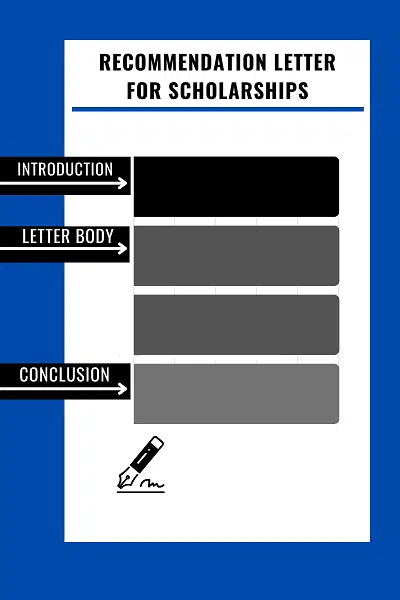
Formatting tips for a recommendation letter for scholarships
It complies with the requirements that you have been given: For example, the university can request that the letter of recommendation for scholarships follow a predetermined structure, be written by particular individuals, and/or be sent in a sealed envelope. If so, do as instructed since the failure to comply with these application conditions may result in your instant disqualification.
- Language of recommendation letter: If it is for an English program, it is preferred that it be written in that language and that the individual acting as a reference can respond to inquiries in that language. However, since you can provide an official translation with your letter of recommendation for scholarships, it is not necessary to handle it in this manner.
- Recommendation letter Size: The length of the recommendation letter for scholarships should be between 1-1.5 pages long, written in Times New Roman, Arial, or Calibri, size 12, with standard margins and spacing. This will ensure that it is both concrete and sufficiently descriptive.
- Letterhead: The letter of recommendation for scholarships should ideally be written on letterhead from the school to which the instructor belongs. This increases the formality and confidence of the document.
In the upper left corner of their recommendation for scholarships, recommenders should provide the following details:
- Date
- Full name
- Title
- Institution name
- Official address
- City, state, and zip code
- Preferred contact information
- Contact information: The professional letter of recommendation for scholarships must clearly state the recommender’s name, phone number, address, and email. The assessing institution will then have the chance to verify the information by getting in touch with the individual who made the recommendation for you.
Reference letter template
Although using a Reference letter template can save time and effort, it may reduce the strength of the letter of recommendation, as it speaks in general terms without addressing the qualities that make each student distinct from others.
So, if you have enough time to craft a unique reference letter for each student, we recommend not to use a reference letter template. Your qualified students trusted you to write a reference letter for a scholarship, so they deserve to get a distinctive reference letter that focuses on their personal merits and does not make them seem similar to their peers.
However, you can take advantage of the reference letter template and use it as an initial template that must be modified to make it unique.
In this case, we hope that the following reference letter template is beneficial:
Day/Month/Year
[Recommender’s Name or Institution’s Name]
[Address]
[City, State Zip code]
To Whom It May Concern:
I have the pleasure of enthusiastically endorsing [Applicant Name] for admittance to [University Name].
I am [Recommender’s Name], a [his/her position] at [his/her Institution]. I have an experience of [number] years working in [recommender’s academic focus]. During these years I have seen a lot of young professionals come and leave. Although I have worked with a few students who stick out, [Candidate Name] is one in special.
While we were working together, [Applicant Name] showed exceptional talent in [skill, attribute, experience, class, etc.]. I was pleased by [Applicant’s Name] when we initially met, but as we worked together, I noticed that she had a far deeper grasp of [important topic] than his/her colleagues.
[Insert a personal tale highlighting important skills, traits, or experiences].
However, I’m impressed by more than just his/her technical skills. Because of [good characteristic] and his/her incredibly upbeat attitude, [Applicant Name] was a delight to work with. His/Her [positive characteristic] and [positive characteristic] were valued not only by me but also his/her colleagues, who frequently counted on him/her to complete the tasks.
I have no doubt that [Applicant Name] would make a fantastic addition to your institution. He/She will not only bring the qualifications and experiences you’re looking for in a candidate but he/she will also work hard to establish himself/herself as a valuable member of your institution and develop it in any possible way.
Please don’t hesitate to contact me at [contact information] if you require any further details or particular instances. I would be pleased to go into more detail about my experience working with him/her since a reference letter probably only gives a brief overview of her skills and accomplishments.
Sincerely,/regards,
[Recommender’s Full Name, Institution, and Title]
Now, after having a look on the reference letter template, Reading a recommendation letter sample can help you better understand how to write a recommendation letter for student.
Recommendation Letter Sample
Reading a recommendation letter sample or reference letter sample can enhance your understanding of the points that you should attach importance to in your reference letter the most.
First recommendation letter sample
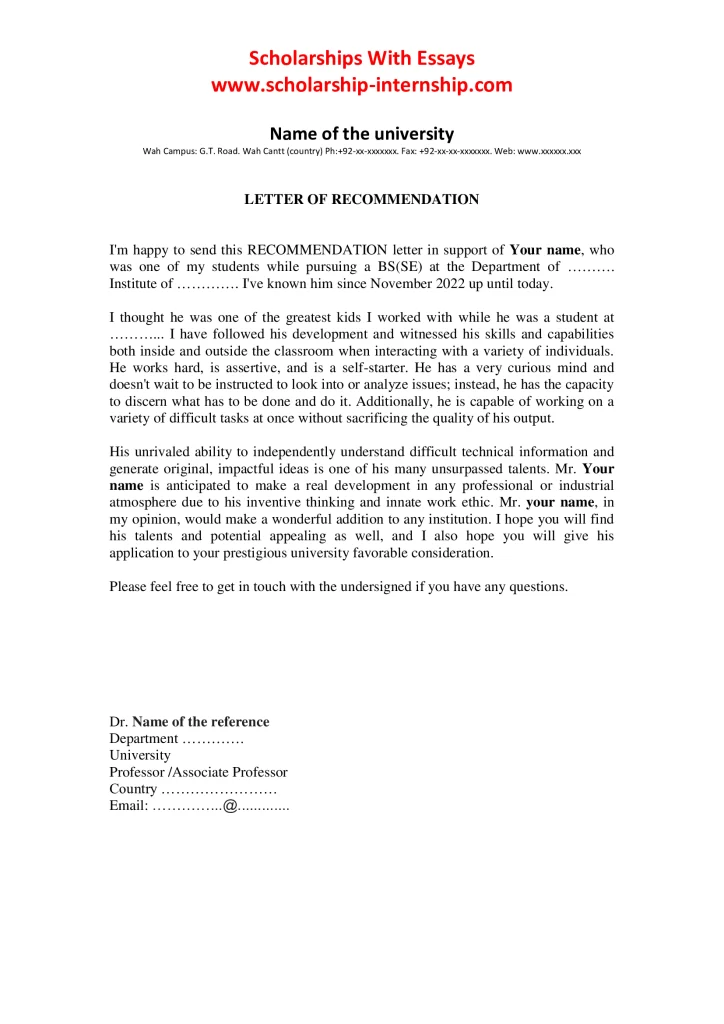
Second recommendation letter sample
December 17, 2022
College Scholars Programme
University of Tennessee
123 Business Rd.
Business City, NY 54321
To Whom It May Concern:
I wholeheartedly endorse John Bloom’s enrollment in the University of Tennessee’s College Scholars Program.
Throughout John’s four years at Morristown-Hamblen High School, I taught him a number of English subjects, including AP English his junior year. Joe demonstrated a degree of creativity, humor, and critical thinking in our classes that is quite uncommon among high school students.
His writing and research skills are absolutely exceptional; for his major AP English essay project, he conducted extensive research and authored a stunning study of visual imagery in Edgar Allan Poe’s writings.
John’s broad intellectual range makes him bored by the majority of Liberal Arts courses for freshmen and sophomores. He is prepared to take on and succeed in upper-division coursework, and he has the drive necessary to successfully create and carry out an individual course of honors study.
As the two-year drum major of our band, vice president of the student council, and editor of our high school yearbook, Joe has displayed leadership qualities that complement his academic talents. Additionally, he participates actively in both his church and the Sierra Student Coalition.
Please let me know if there is anything further I can do to support John’s candidacy for the College Scholars Program.
He has a really unique spark, and I have no doubt that he will go far in improving our world.
Sincerely,
Samantha Evans (signature hard copy letter)
Samantha Evans
Third recommendation letter sample (reference letter example)
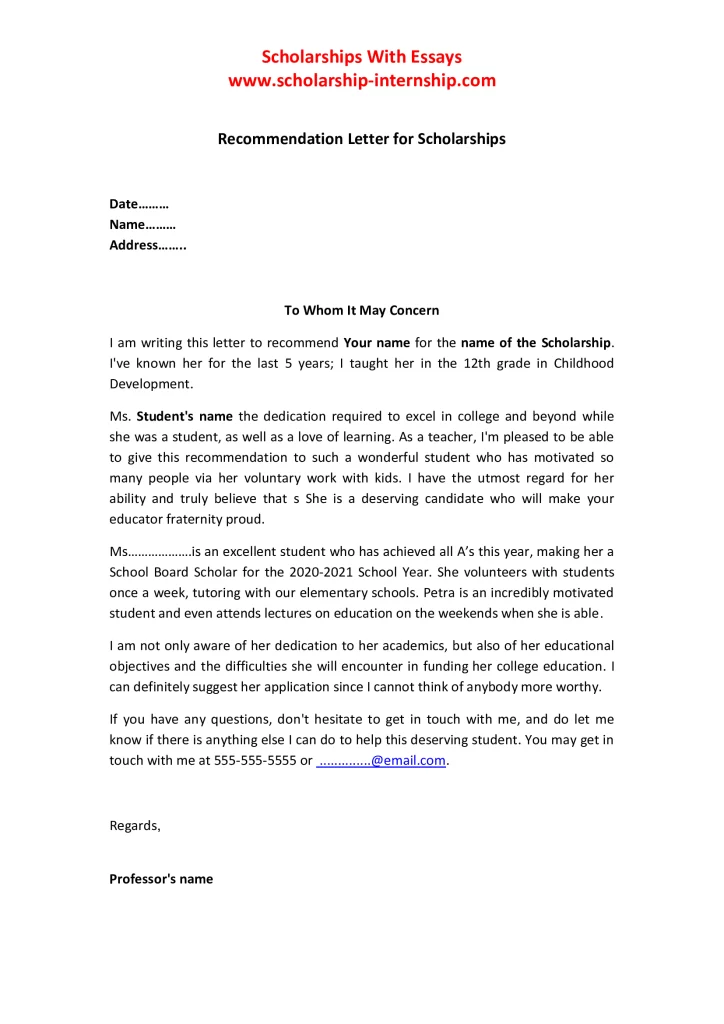
Fourth recommendation letter sample
January 1, 2023
Rachel Robinson
Literature and English Teacher
Nevermore High School
123 Park Street
Anytown, CA 12345
Dear Sir or Madam:
I write this letter in support of (student’s name) candidacy for the (Name of the scholarship), I am submitting this letter. She was in my English Literature and Composition classes during the 10th, 11th, and 12th grades at Nevermore High School. Her capacity to explain complex ideas and comprehend dense texts has always astounded me. He/She stands out both as a student and a writer because of her sensitivity to literary nuances and her enthusiasm for reading and writing.
(Candidate’s name) wrote an outstanding research paper on historical literature during her/his senior year in which she compared works from 3 distinct eras and combined cultural and historical viewpoints to guide her/his study. When asked to present in front of her peers, she/he did so with clarity and consideration, and she/he answered all of their inquiries intelligently. Although she/he has a bright future as a student, poetry is what she/he is most passionate about. She/He contributes poems to the school newspaper and has also had work published in blogs and online journals.
(your name) participated in our discussions during the whole year and consistently supported her peers. Since she/he constantly values other people’s perspectives, her/his compassionate character and personality enable her/him to work effectively in a group. Her/his poems and her literary works are affected by this openness, which she employs.
I have no doubt that he/she will carry on producing wonderful and original work in the future. Her work has an astounding depth for someone so young, as I’m sure you’ll agree. If you have any questions, don’t hesitate to get in touch with me at Example@email.com.
Sincerely,
Reference/Professor Name
Fifth recommendation letter sample
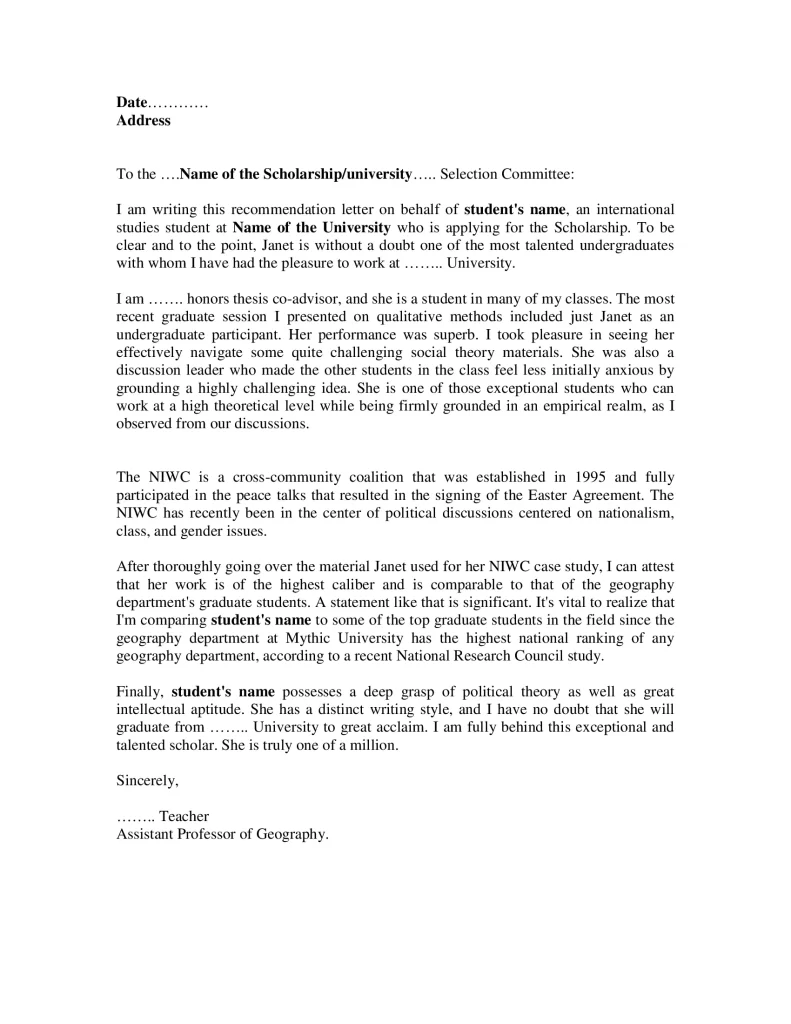
Tips for instructors to craft a professional letter of recommendation for scholarships
Assess your ability to produce a strong letter for the application
Take into account your schedule, the extent to which you know the candidate, and the type and quality of your relationship with them. If you find it difficult to come up with something to say in a reference letter for scholarships, you should choose to reject it. This leads me to…
Saying no is appropriate
I advise instructors to create a procedure for writing a letter of recommendation that specifies the standards for academic achievement, a deadline, and any other details they think are necessary. Make sure your policy is implemented consistently and is truthful. If you say you’ll need three weeks to write, don’t turn away someone who asked 10 days before the deadline while agreeing to write for someone else who asked at the same time. People talk. A bad reputation is not something you want to acquire. Do not forget that students also assess professors.
Ask as many questions as you can before you start writing a scholarship recommendation letter
Request information from the student on both themselves and the opportunity or programme they are applying to. A resume/curriculum vitae, a personal statement and essays, answers to application questions, transcripts, and, of course, information about the school, program, or job for which they are seeking are all included. These materials are beneficial add-ons to more in-depth personal narratives.
Do some research
Take 4 minutes to Google the institution or program if you agree to write the scholarship reference letter but they do not deliver you the needed materials. I’m not saying you should do all the research, but simply knowing more information can be useful for your scholarship recommendation letter.
Simply review the student’s performance in your course and solicit feedback from your peers if that seems like too much work. It’s better to have some information than none.
Allocate enough time. Like a good paper
A professional reference letter has to be well-researched, planned, and revised. A letter that you can write in less than an hour might not be your finest effort. You may not be going into enough depth if the letter is simply two paragraphs long and double-spaced. After all, don’t you anticipate that students would write thoughtfully and thoroughly? No less should be done for them.
Be precise
The most crucial piece of advice could be this. The most unpleasant part about being on a search committee may be reading vague reference letters packed with generalized claims of brilliance. Give precise instances to back up your claims. Write as vividly as possible to give readers a realistic impression of the applicant’s personality outside of the classroom, if not in real life.
Avoid using cliched descriptors and platitudes
Almost all recommendation letters for scholarships contain words like organized, team worker, creative, enthusiastic, and devoted. No matter how precise these descriptions are, when you read the same line repeatedly, you get the impression that they aren’t very deep. Instead, consider the abilities necessary for the open post and decide if the candidate possesses them. If not, point out what they do have and make it clear why that specific skill is advantageous.
Create a chronological or thematic organization for the scholarship reference letter. Have an introduction that states the position being sought, the type and length of your relationship with the applicant, and a preview of the topic you will be discussing. Make sure you conclude with a concise endorsement for acceptance or hiring and offer contact details for queries. Although it seems obvious, many recommendation letters for scholarships lack the fundamentals (which is usually a sign that it is a form letter).
Be truthful, original and true to yourself
That entails refraining from having students compose their own letters. It entails avoiding using the same letter for everyone. It categorically implies staying away from online reference letter template borrowing. Form letters are obvious and frequently lead to the applicant’s application being rejected. Why would the selection committee want to hire them if you don’t even want to write a reference letter for them?
Follow through
You have been given a significant task by this student. It is your obligation to complete it efficiently and on time since you agreed to do it. An application package might become incomplete and hence unworthy of consideration if one of its components is late or absent.
Tips for students to get an excellent recommendation letter for scholarships
- Ask for the recommendation letter for scholarships in time: The recommenders who are going to write a reference letter for scholarship will most likely have many responsibilities, so they will need at least one month to write your letter of reference. Keep that in mind to be able to send all the complete documentation by the application deadline without having to urge the instructor to write the reference letter as quickly as possible.
- Send the instructors/professors who are going to write your recommendation letter for scholarships a copy of your resume and a cover letter: The individuals who will compose your reference letter for scholarship should ideally be aware of your accomplishments and the reasons you want to participate in the program to which you are applying. So, if you aim to get an excellent recommendation letter for scholarships, it is strongly recommended that you meet them to share your experience and plans, or to share documents like your CV and cover letter or a document with the following :
- Name, grade, test scores, and GPA of the student
- The name of the scholarship, requirements for application, and the URL of the webpage with further details
- The due date for your reference letter as well as instructions for submitting it
- 3–4 sentences outlining their qualifications for the scholarship in their own words
- 2-3 of their best academic accomplishments either inside or outside of school
- 2-3 extracurricular accomplishments they are proud of from either within or outside of school
- If they applied for a scholarship, a brief summary (200 words maximum) of what they covered in that essay, being careful not to repeat details they’ve previously addressed in-depth.
Do’s & don’ts when writing a recommendation letter for student
A successful recommendation letter for scholarships should:
- Compare the student’s performance in a relevant and tangible manner. A professional recommendation letter for student includes a numerical comparison for the selection committee, such as “among the top 3 percent of students in my 15 years of teaching” or “the student is among the top 5 I have taught over the previous 10 years”;
- Bring up specific instances of the student’s work, such as a stellar final paper, a significant semester-long research project, etc. Whenever feasible, use anecdotes since they make for far more interesting reading.
- Discuss the merits of the student’s suggested research strategy or plan, particularly in light of the opportunity.
- Describe how the fellowship or opportunity will affect the student’s career or academic trajectory, giving examples of how the fellowship will help the student achieve their long-term goals;
And lastly, a powerful letter should include plenty of convincing details. The selection committee needs to observe the student both as a person and as a candidate in action.
A detailed and enthusiastic recommendation letter for student will expand the selection committee’s comprehension of the student, much like specificity is crucial to a successful fellowship essay.
A successful recommendation letter for scholarships should avoid:
- General language / excessively broad descriptors of the student’s classroom performance.
- Concentrating on a student’s ability to finish the readings or their punctuality. Letters should go far more than just outlining basic expectations.
- Too much time and effort spent on describing the relationship with the student or the course material. Usually, 2 to 3 words detailing how you met the student and the course’s objective are sufficient.
- Weak compliments or underhanded praises. While providing frank and constructive criticism may be appropriate in some situations (some selection committees like when reference letter writers mention possible growth and development areas), the student’s eligibility for the opportunity should be highlighted in a few words and pages provided.
A powerful recommendation letter for scholarships gives passionate endorsement for the student’s eligibility, supporting their application materials and giving faculty members exclusive access to the student’s qualifications. You can and should decline a student’s request if you believe that you can’t offer anything less than enthusiastic assistance.
Because writing a reference letter for scholarships can be much easier after reading samples, we recommend you read every recommendation letter sample, and reference letter template available in this article carefully.
Read also, Motivation Letter for Scholarship in simple words
If you are a talented student aiming to find the best scholarship for you, we are here to provide you with plenty of scholarships for bachelor’s, master’s and PhD levels by Scholarships with Essays website.
You can also read more about reference letters from Wikipedia.



